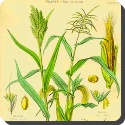 Millet — The millets are a group of small-seeded species of cereal crops or grains, widely grown around the world for food and fodder. They do not form a taxonomic group, but rather a functional or agronomic one. Their essential similarities are that they are small-seeded grasses grown in difficult production environments. It was millets, rather than rice, that formed important parts of prehistoric diet in Chinese Neolithic and Korean Mumun societies.
Millet — The millets are a group of small-seeded species of cereal crops or grains, widely grown around the world for food and fodder. They do not form a taxonomic group, but rather a functional or agronomic one. Their essential similarities are that they are small-seeded grasses grown in difficult production environments. It was millets, rather than rice, that formed important parts of prehistoric diet in Chinese Neolithic and Korean Mumun societies.
The protein content in millet is very close to that of wheat; both provide about 11% protein by weight.
Millets are rich in B vitamins, especially niacin, B6 and folic acid, calcium, iron, potassium, magnesium, and zinc. Millets contain no gluten, so they cannot rise for bread. When combined with wheat or xanthan gum (for those who have coeliac disease), though, they can be used for raised bread. Alone, they are suited for flatbread.
As none of the millets are closely related to wheat, they are appropriate foods for those with coeliac disease or other forms of allergies/intolerance of wheat. However, millets are also a mild thyroid peroxidase inhibitor and probably should not be consumed in great quantities by those with thyroid disease.
It is grown as a major food grain in Africa and Asia. Millet seeds grow on long spikes, or panicles, at the ends of stalks that range in height from 0.3 to 3 m (1 to 10 ft). The strongly flavored grain is ground and eaten as porridge or in flat breads. Because millet will grow in relatively infertile soil, has a high tolerance to drought, and matures in only 6 to 12 weeks, it is widely cultivated a a food crop in less developed agricultural regions. World production of millet in 1990 exceeded 30 million metric tons.
 Kids Portal For Parents India Kids Network
Kids Portal For Parents India Kids Network






